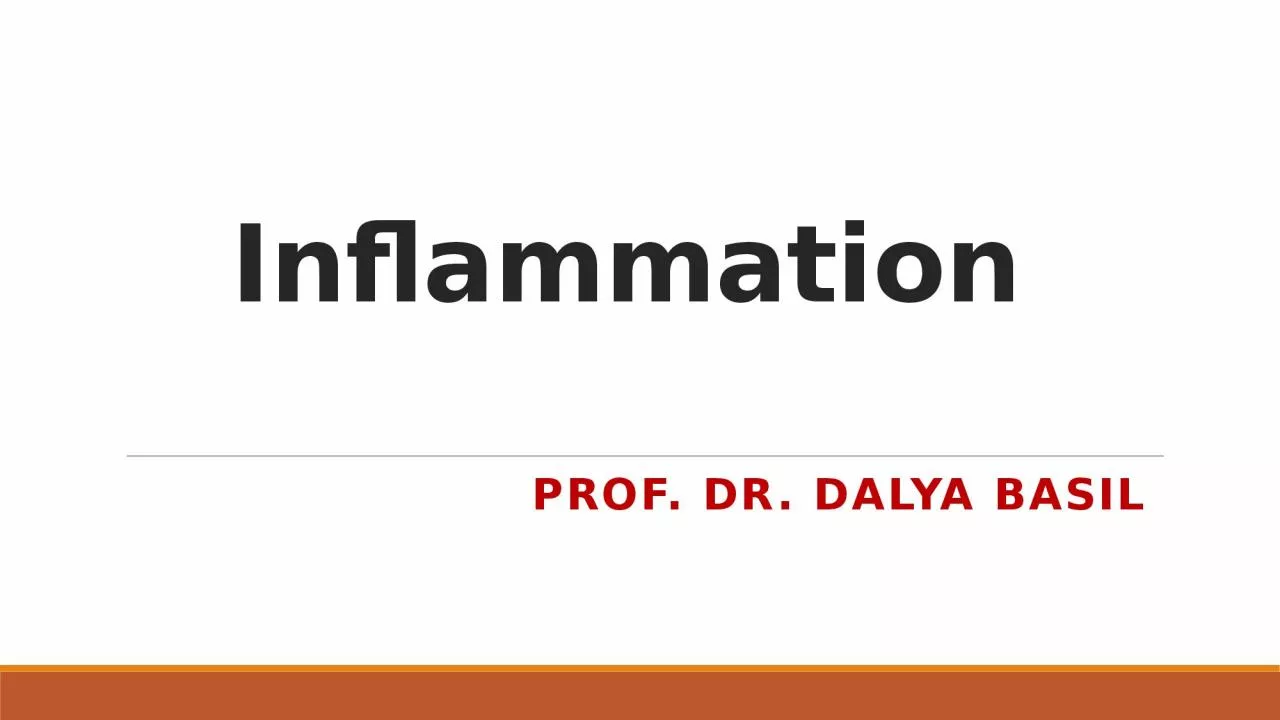

Steps of inflammatory response 1 Recognition of injurious agent 2 Recruitment of leukocytes 3 Removal of the agent 4 Regulation of response 5 Resolution Acute Inflammation Acute inflammation is the early almost immediate reaction of local tissues and their blood vessels to injury ID: 1032867
Download Presentation The PPT/PDF document "Inflammation Prof. Dr. Dalya Basil" is the property of its rightful owner. Permission is granted to download and print the materials on this web site for personal, non-commercial use only, and to display it on your personal computer provided you do not modify the materials and that you retain all copyright notices contained in the materials. By downloading content from our website, you accept the terms of this agreement.
1. Inflammation Prof. Dr. Dalya Basil
2. Steps of inflammatory response1- Recognition of injurious agent2- Recruitment of leukocytes3- Removal of the agent4- Regulation of response5- Resolution
3. Acute InflammationAcute inflammation is the early (almost immediate) reaction of local tissues and their blood vessels to injury. It is aimed primarily at removing the injurious agent and limiting the extent of tissue damage. Acute inflammation can be triggered by a variety of stimuli, including infections, blunt and penetrating trauma, physical or chemical agents (e.g., burns, frost-bite, irradiation, caustic chemicals), and tissue necrosis from any cause.
4. Cardinal Signs of InflammationPain: Chemicals that stimulate nerve endings are released, making the area much more sensitive.Redness: Capillaries are filled up with more blood than usual.Swelling: Accumulation of fluid.Heat: as with the reason for the redness, more blood in the affected area makes it feel hot to the touch.Immobility: there may be some loss of function.
5. Vascular and Cellular Stages of Acute InflammationVascular Stage: The vascular changes that occur with inflammation involve the arterioles, capillaries, and venules of the microcirculation. These changes are characterized by vasodilation and changes in blood flow followed by increased vascular permeability and leakage of protein-rich fluid into the extravascular tissues. Vasodilation, follows a transient constriction of the arterioles, lasting a few seconds. As a result, the area becomes congested, causing the redness (erythema) and warmth. Vasodilation is induced by the action of several mediators, most notably histamine and nitric oxide.
6. Vascular Stage Vasodilation is quickly followed by increased permeability of the microvasculature, with the outpouring of a protein-rich fluid (exudate) into the extravascular spaces. The loss of fluid results in an increased concentration of blood constituents (red blood cells, leukocytes, platelets, and clotting factors), stagnation of flow, and clotting of blood at the site of injury. This aids in localizing the spread of infectious microorganisms. The most common mechanism of vascular leakage is elicited by histamine, bradykinin, leukotrienes, and many other classes of chemical mediators.
7.
8. Cellular Stage- Leukocytes emigration, accumulation, activation of leukocytes, enabling them to eliminate the offending agent. Principal leukocytes are polymorpho nuclear leukocytes (Neutrophils). - Leukocyte recruitment In this step there is sequence of events:1) Margination and rolling: as blood flows, circulating cells are swept by laminar flow against the vessel wall. Larger leukocytes are pushed out of central axial column and thus interact with lining endothelial cells (margination).
9. Cellular Stage If endothelial cells are activated by cytokines and mediators-express adhesion molecules to which leukocytes attach loosely, these cells bind and detach and thus begin to tumble on endothelial surface, a process called rolling. Mediated by selectin family of adhesion molecules, three members are- E-selectin (on endothelial cells), P-selectin (on platelets), and L-selectin (on surface of most leukocytes). All selectins are induced after stimulation.
10. Cellular Stage2) Adhesion: Rolling leukocytes sense changes, then initiate firm adhesion which is mediated by integrins - leukocyte cell surfaces and ligands on endothelial cells. Cytokine stimulated increased integrin affinity and increased expression of integrin ligands provides stable attachment of leucocytes to endothelial cells at sites of inflammation.
11. Cellular Stage3) Transmigration:By squeezing between cells at intercellular junctions called diapedesis, mainly in venules of systematic vasculature. Leucocytes secrete collagenases, pass through the vascular basement membrane.4) Chemotaxis:After extravasating from blood, leukocytes move toward sites of infection or injury along a chemical gradient by a process called chemotaxis.Chemotactic substances: such as soluble bacterial products, cytokines and others.
12. Cellular Stage Leukocytes move by extending pseudopods that anchor to ECM and then pull the cell in direction of extension. Neutrophils predominate in inflammatory infiltrate during first 6 to24 hours and are replaced by monocytes in 24 to 48 hours. 5) Leukocyte activation: Cellular receptors responses in leukocytes result in defensive function and leukocyte activation.
13. * Key to the normal function of leukocytes in host defense is to ensure that they are recruited and activated only when needed.
14.
15.
16. Local manifestation of Acute Inflammation Local manifestation of acute inflammation can be range from mild swelling and redness to abscess or ulceration. Charactestically the acute inflammatory response involves the production of exudates, which vary in terms of fluid type, plasma protein content, and presence or absence of cells. Exudates can be: Serous Hemorrahgic Fibrinous Membranous Purulant
17.
18. THANK YOU